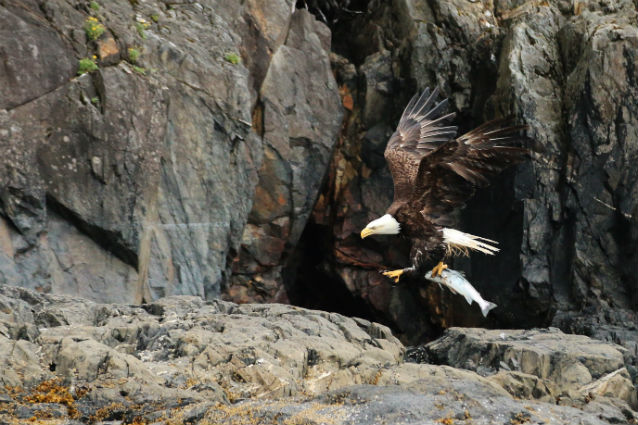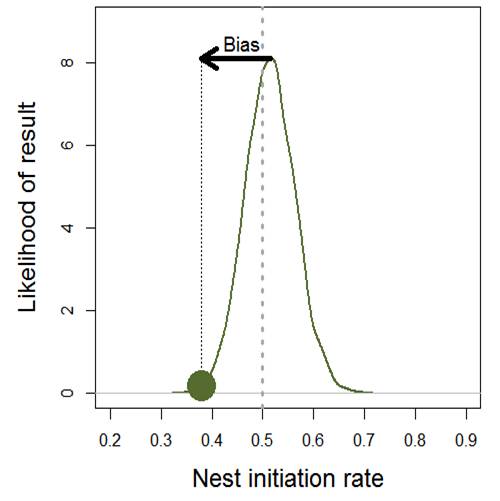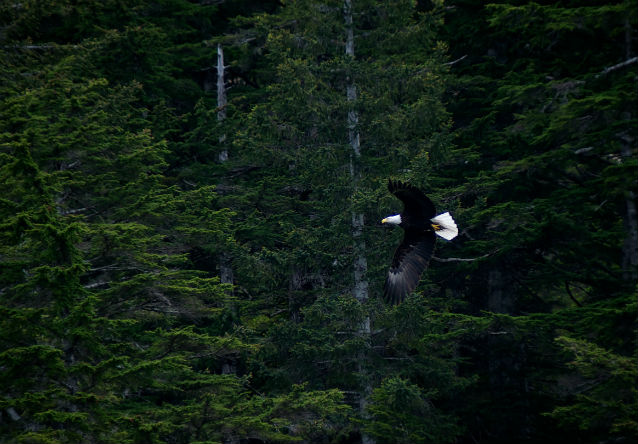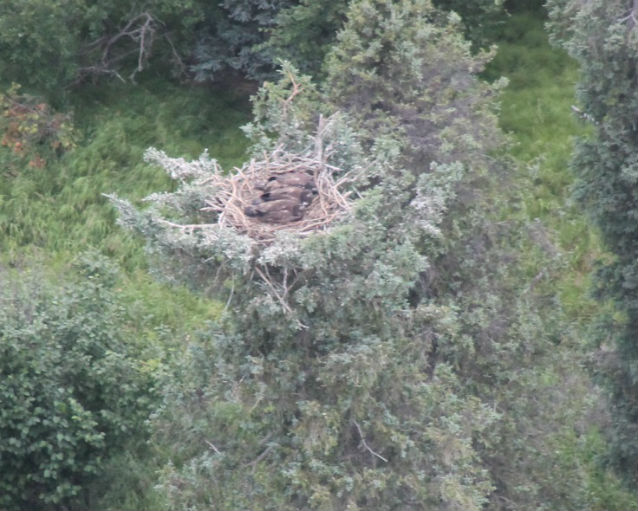Importance

NPS/Kaiti Chritz
All three Southwest Alaska Network (SWAN) park units support large populations of bald eagles. Bald eagles were once listed as an endangered species in the contiguous 48 states due to human-caused declines. Populations have since recovered, and bald eagles were delisted in 2007. As top predators, bald eagles can serve as indicators of the overall health of local ecosystems. Their breeding success is influenced by food availability and spring weather conditions. Understanding the status and trends of local populations can assist managers in addressing future questions on the impacts of visitor access or other human caused disturbances, such as oil spills.
Findings

Bald eagle nest monitoring continues to improve at SWAN parks. In 2014, ecologists discovered a key weakness of the bald eagle monitoring protocol that could lead to biased estimates of bald eagle
nest occupancy in parks. The bias arises when the true status of a nest (initiated or empty) is ambiguous during observational nest surveys. For example, in a single survey, it is impossible to know if an empty nest is truly empty, or if the eagles are not in the nest during the survey. Two surveys can be used to correct any bias from this ambiguous status.
This bias is shown for the 2014 surveys in Lake Clark National Park and Preserve (see figure). Bald eagle populations are considered to be stable if nest initiation rates (identifying whether nests are occupied or not) are greater than 0.5. The results from one survey is shown by the green circle. The curved line demonstrates what the biascorrected results look like when two nest surveys are completed. From this figure, it is clear that one nest survey does not result in the most accurate information on eagle nests.
Results of our recent analyses confirm that a negative bias in nest initiation rates is present in most cases. Biased estimates can be problematic for wildlife managers because they could lead to
incorrect management actions. To correct for bias in nest monitoring, it is recommended that parks conduct two occupancy surveys during the nest initiation period in May.
Status

NPS/Paige Calamari
Bald eagle nest productivity (calculated by the average number of chicks produced for each nest in a given year) in Katmai National Park and Preserve (NPP), Kenai Fjords National Park (NP), and Lake Clark National Park and Preserve (NPP) are shown in the table below. Bald eagle populations are also considered stable if the average number of chicks produced for each nest is greater than 0.7. In the table below, many parks have stable bald eagle populations. The confidence intervals for each estimate are also listed. (In statistics, a 95% confidence interval is a range of values where one can be 95% certain that the interval contains the true value of the average number of chicks.)
SWAN’s new double occupancy survey model improves how productivity data are analyzed, because it lessens the bias of determining whether an eagle nest is occupied or not.
| Park | Year | Productivity | Lower 95% Confidence Interval | Upper 95% Confidence Interval |
| Katmai NPP | 2015 | 1.04 | 0.68 | 1.46 |
| Kenai Fjords NP | 2014 | 0.90 | 0.64 | 1.23 |
| Kenai Fjords NP | 2015 | 0.77 | 0.53 | 1.05 |
| Lake Clark NPP | 2013 | 0.67 | 0.46 | 0.88 |
| Lake Clark NPP | 2014 | 0.92 | 0.69 | 1.19 |
Discussion

NPS
Ecologists at SWAN and SWAN parks are finalizing the official monitoring plan and standard operating procedures. These protocols feature important advancements in data collection and analysis. Look for it on the National Park Service's Integrated Resource Management Applications (IRMA) prior to the onset of field sampling in May.
Bald eagles often have more than one nest in their territories. A recent study by Watts (2015) analyzed the value of protecting alternate nests from both a biological and economic perspective. The study found that alternate nests have a 70% chance of surviving to the next year, compared to 90% of primary nests. Further, the probability that a nest or nest tree would be reused or rebuilt (if lost) by the resident pair declined with the amount of time since the last nest was used. This decline in probability of nest reuse meant that the cost-to-benefit ratio of protecting alternate nests does not extend beyond three years post-abandonment.
For More Information
Contact Tammy Wilson, tammy_wilson@nps.gov
https://science.nature.nps.gov/im/units/swanmonitor//wildlife.cfm
Watts, B.D. 2015. Estimating the residual value of alternate bald eagle nests: implications for nest protection standards. The Journal of Wildlife Management 79:776-784.
Web article created by: Erin Kunisch
https://www.nps.gov/rlc/oceanalaska/index.htm
Updated March 2016
Click here to print a copy of this article.
Last updated: October 26, 2021
